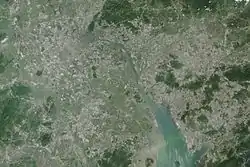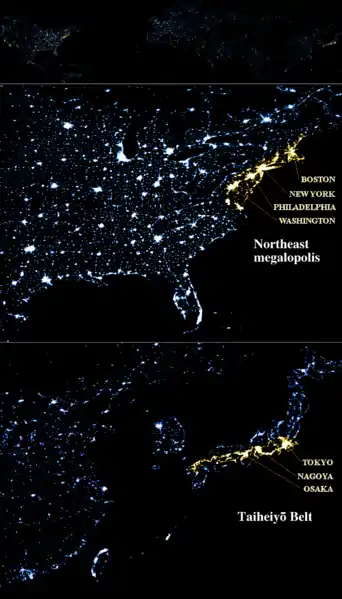Megalopolis
A megalopolis (/ˌmɛɡəˈlɒpəlɪs/) or a supercity,[1] also called a megaregion,[2] is a group of metropolitan areas which are perceived as a continuous urban area through common systems of transport, economy, resources, ecology, and so on.[2] They are integrated enough that coordinating policy is valuable, although the constituent metropolises keep their individual identities.[2] The megalopolis concept has become highly influential as it introduced a new, larger scale thinking about urban patterns and growth.[3]

| Ekistics |
|---|
.jpg.webp) |
|
|
Etymology and earlier definitions
The term has specific geographic definitions dating from 1832, when its meaning was "a metropolis," that is, "a very large, heavily populated urban complex".
In the late 1950s and early 1960s, Jean Gottmann, a professor of political science at the University of Paris and member of the Institute for Advanced Study at Princeton, directed "A Study of Megalopolis" for The Twentieth Century Fund, wherein he described a megalopolis as a "world of ideas". Gottmann, in his extensive studies, applied the term megalopolis to an analysis of the urbanized northeastern seaboard of the U.S., in particular from Boston, Massachusetts to Washington, D.C.
Modern definitions

A megalopolis may also be called a megaregion. "Megalopolis" and other similar terms have been used by different scholars and countries to describe similar spatial forms.
A megalopolis, following the work of Gottmann, refers to two or more roughly adjacent metropolitan areas that, through a commonality of systems—e.g., of transport, economy, resources, and ecologies—experience a blurring of the boundaries between the population centers,[2] such that while some degree of separation may remain, their perception as a continuous urban area is of value, e.g., "to coordinate policy at this expanded scale".[2] Simply put, a megalopolis (or a megaregion[4]) is a clustered network of big cities. Gottmann defined its population as 25 million,[5] while Doxiadis defined a small megalopolis a similar cluster with a population of about 10 million.[4][6] America 2050,[7] a program of the Regional Plan Association (RPA), lists 11 megaregions in the United States and Canada.
Megaregions of the United States were explored in a July 2005 report by Robert E. Lang and Dawn Dhavale of the Metropolitan Institute at Virginia Tech.[8] A later 2007 article by Lang and Nelson uses 20 "megapolitan" areas grouped into 10 megaregions.[9] The concept is based on the original "Megalopolis model".[6]
Modern interlinked ground transportation corridors, such as rail and highway, often aid in the development of megalopolises. Using these commuter passageways to travel throughout the megalopolis is informally called megaloping, a term coined by Davide Gadren and Stefan Berteau.[10]
In Brazil, the term megarregião has a legal meaning, different from the English word megaregion: mesoregions of Brazil (mesorregião) and microregions of Brazil (microrregião).
In China, the official term corresponding to the meaning of "megalopolis" is '城市群' (chéngshì qún), which, in Chinese, was originally coined by Yao Shimou and literally means "city cluster".[11] A "city cluster" is defined as "[a]n area in which cities are relatively densely distributed in a certain region". In an older standard, the term was mistranslated as "agglomeration".[12][11] In 2019, National Development and Reform Commission (NDRC) published guidelines and made a distinction from a similar concept "metropolitan area" (都市圈), which is of a smaller scale than a city cluster.[13] In the latest standard terminologies of both economics[14] and urban planning,[15] 城市群 is translated as "city cluster", replacing "agglomeration".
List of megalopolises
In popular culture
Metropolis
Metropolis is a 1927 German expressionist science-fiction drama film directed by Fritz Lang. Written by Thea von Harbou in collaboration with Lang,[16][17] it stars Gustav Fröhlich, Alfred Abel, Rudolf Klein-Rogge and Brigitte Helm. Erich Pommer produced it in the Babelsberg Studios for Universum Film A.G. (Ufa). The silent film is regarded as a pioneering science-fiction movie, being among the first feature-length movies of that genre.[18] Filming took place over 17 months in 1925–26 at a cost of over five million Reichsmarks.[19]
Judge Dredd
In the Judge Dredd (1977) comic book series and its spinoff series, Mega-City One is a huge fictional megalopolis-size city-state covering much of what is now the Eastern United States and some of Canada. The exact geography of the city depends on which writer and artist has done which story, but from its first appearance it has been associated with New York City's urban sprawl; originally it was presented as a future New York, which was retconned as the centre of a "Mega-City One" in the very next story.[20] The Architects' Journal placed it at No. 1 in their list of "comic book cities".[21]
Blade Runner
Blade Runner is a 1982 neo-noir science fiction film directed by Ridley Scott, written by Hampton Fancher and David Peoples, and starring Harrison Ford, Rutger Hauer, Sean Young, and Edward James Olmos. It is a loose adaptation of Philip K. Dick's novel Do Androids Dream of Electric Sheep? (1968). The film is set in a dystopian future Los Angeles of 2019, in which synthetic humans known as replicants are bio-engineered by the powerful Tyrell Corporation to work on off-world colonies. When a fugitive group of replicants led by Roy Batty (Hauer) escapes back to Earth, burnt-out cop Rick Deckard (Ford) reluctantly agrees to hunt them down.
Sprawl trilogy
In William Gibson's Sprawl trilogy, "the Sprawl" is a colloquial name for the "Boston-Atlanta Metropolitan Axis" (BAMA), an urban sprawl environment on a massive scale, and a fictional extension of the real Northeast megalopolis. The Sprawl is a visualization of a future where virtually the entire East Coast of the United States, from Boston to Atlanta, has melded into a single mass of urban sprawl.[22] It has been enclosed in several geodesic domes and merged into one megacity. The city has become a separate world with its own climate, no real night/day cycle, and an artificial sky that is always grey.
Further reading
- Hagler, Yoav (November 2009). "Defining U.S. Megaregions" (PDF). America 2050. Retrieved February 19, 2022 – via RPA.org. This work, while dated, is from Associate Planner Yoav Hagler of America 2050, and while not used as a source in this article, is one of the most focused articles available on the American aspects of the title subject. It includes history, methodology, and statistical and other criteria sections, and identifies the U.S. megaregions as of its publication date.
- America 2050 Staff (February 19, 2022). "Megaregions". America 2050. Archived from the original (homepage) on May 16, 2017. Retrieved February 19, 2022 – via RPA.org. Starting point for access to articles from the America 2050 effort, while it was active. Note, an earlier cited article by Matt Taylor, on urban transit issues, appears among the works linked at this home page.
See also
- Arcology
- Conurbation
- Ecumenopolis
- Ekistics
- Settlement types:
- Global city
- Merger (politics)
- Transborder agglomeration
- Urban area
- Developed environments:
References
- Fielder, W. & Feeney, Georgiana (1976). Inquiring about Cities. New York, N.Y.: Holt, Rinehart and Winston (Georg Von Holtzbrinck/Holt). pp. 193, 299. ISBN 9780030897849. Retrieved June 25, 2018.
{{cite book}}: CS1 maint: multiple names: authors list (link) - Hagler, Yoav (November 2009). "Defining U.S. Megaregions" (PDF). America 2050. Retrieved February 19, 2022 – via RPA.org.
As metropolitan regions continued to expand throughout the second half of the 20th century their boundaries began to blur, creating a new scale of geography now known as the megaregion. Interlocking economic systems, shared natural resources and ecosystems, and common transportation systems link these... The challenge of identifying... emerging regions has been undertaken... The most recent iteration... has been developed by Regional Plan Association (RPA) in partnership with the Lincoln Institute of Land Policy. Eleven such megaregions have been identified... that would make cooperative integrated planning advantageous... Th[e] tradition of geographers and planners attempting to enhance the value of geographic definitions to meet the needs of new generations continued with the first identification of a scale larger than the metro regions by French geographer Jean Gottmann in his 1961 book Megalopolis. This "Megalopolis" referred specifically to the Northeastern United States ... Regional Plan Association also identified this emerging Northeast Megaregion in the 1960s.
- Caves, R.W. (2004). Encyclopedia of the City. Abingdon-on-Thames: Routledge (Informa/Taylor & Francis. p. 456. ISBN 9780415252256.
- "Who's Your City?: What Is a Megaregion?". March 19, 2008. Archived from the original on June 12, 2010. Retrieved October 5, 2014.
- Gottmann, Jean (1989). Since Megalopolis. The Urban Writings of Jean Gottmann. Baltimore and London: The Johns Hopkins University Press. p. 163.
- "Cities: Capital for the New Megalopolis". Time. November 4, 1966. Archived from the original on August 27, 2013. Retrieved July 19, 2010.
- "About Us". America 2050. Archived from the original on October 6, 2014. Retrieved October 5, 2014.
- "Beyond Megalopolis: Exploring America's New "Megapolitan" Geography" (PDF). July 2005. Archived from the original (PDF) on March 27, 2009.
- "America 2040: The Rise of the Megapolitans" (PDF). January 2007. Archived (PDF) from the original on July 24, 2013. Retrieved January 5, 2014.
- Tremble, Sam (May 30, 2007). "Fumbling Toward Portland". Philadelphia City Paper. Archived from the original on July 7, 2009.
- 许学强 (XU Xueqiang) 周一星 (ZHOU Yixing) 宁越敏(NING Yuemin) (2009). 城市地理学 [Urban Geography] (in Chinese (China)) (第二版 (2nd ed.) ed.). 高等教育出版社. pp. 27–28. ISBN 978-7-04-025539-3.
- Standard for basic terminology of urban planning (GB/T 50280—98), 1998. "2.0.8 城市群 agglomeration 一定地域内城市分布较为密集的地区。"
- "国家发展改革委关于培育发展现代化都市圈的指导意见" [Guidelines on the Cultivation and Development of Modern Metropolitan Areas] (in Chinese (China)). National Development and Reform Commission. February 19, 2019.
- "城市群" [city cluster]. Termonline. 2020.
- "城市群" [city cluster]. Termonline. 2021.
- Magid, Annette M. (Summer 2006). "Better than the Book: Fritz Lang's Interpretation of Thea von Harbou's Metropolis" (PDF). Spaces of Utopia. No. 2. Universidade do Porto. pp. 129–149. ISSN 1646-4729. Retrieved April 6, 2021.
- Grant, Barry Keith, ed. (2003). Fritz Lang: Interviews. Conversations with Filmmakers Series. Jackson, Mississippi: University Press of Mississippi. p. 14. ISBN 9781578065776.
- "Metropolis (1927)" Science Fiction Film History. Retrieved 15 May 2013. Quote: "Although the first science fiction film is generally agreed to be Georges Méliès' A Trip To The Moon (1902), Metropolis (1926) is the first feature length outing of the genre."
- Hahn, Ronald M. and Jansen, Volker (1998) Die 100 besten Kultfilme [The 100 best cult movies] Munich: Heyne Filmbibliothek. p.396. ISBN 3-453-86073-X (German)
- 2000 AD No. 2 and 3
- Top 10 comic book cities: #1 Mega City One, Architects' Journal, July 8, 2009
- Markoff, John (November 25, 1990). "Ideas & Trends; Art Invents A Jarring New World From Technology". The New York Times. Retrieved July 30, 2008.